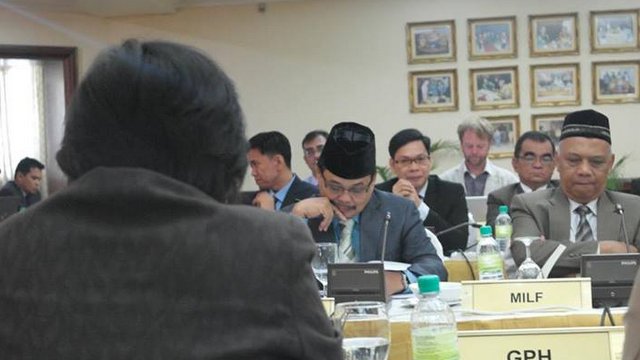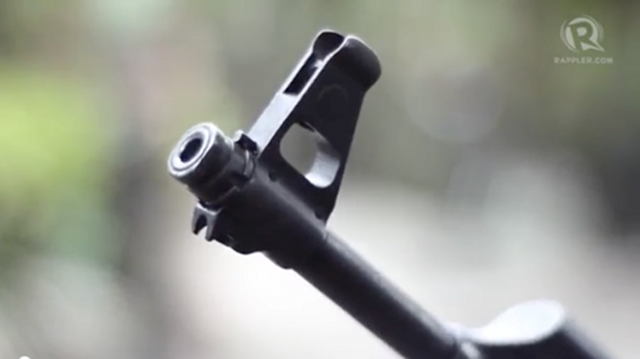SUMMARY
This is AI generated summarization, which may have errors. For context, always refer to the full article.

MANILA, Philippines – The talks that aim to end a 4-decade armed struggle in Mindanao comes to its final chapter – and what’s left pending is the most sensitive issue in the ongoing negotiations.
When the government and the rebel Moro Islamic Liberation Front (MILF) resume negotiations Wednesday, January 22, in Kuala Lumpur, they will discuss what to do with firearms and what would happen next to the people who will lay them down.
While previous deals on power and wealth sharing in the envisioned Bangsamoro political entity required the state to give more than what the current Autonomous Region in Muslim Mindanao presently enjoys, this time around, the ball is in the MILF’s court.
Under the annex on normalization, the MILF will undergo a systematic process of decommissioning of arms in a “gradual and phased” manner.
Government peace panel chair Miriam Coronel Ferrer has warned against using the words “surrender” or “disarmament” in this scenario, especially in the context of the 16-year-old peace negotiations that would soon give rise to a new political entity in Mindanao.
The proposed decommissioning of arms is what distinguishes the 1996 peace agreement signed by the MILF’s rival group, the Moro National Liberation Front (MNLF), from the Framework Agreement (FAB) signed by the MILF in October 2012. The MILF, whose bailiwick is in central Mindanao, had broken away from the MNLF. (READ: The MNLF, MILF and 2 peace agreements).
“The concept of decommissioning or disarmament was not yet in the consciousness of the 1996 peace agreement,” Presidential Adviser on the Peace Process Secretary Teresita Deles said in a House committee hearing back in October – a month after the MNLF siege of Zamboanga City.
Lessons from the past
Back in 1996, under the Ramos government, MNLF troops voluntarily gave up their arms in exchange for cash through the Balik-Baril program, which meant that the MNLF, as an organization, was not obliged to drop its weapons.
This time around, MILF chief negotiator Mohagher Iqbal said the decommissioning of firearms would not correspond to immediate cash incentives.
Instead, both sides envision a normalization process that would entail confidence-building measures from both the government and the MILF.
“The normalization process will occur in parallel tracks. As the MILF decomissions its arms, the government will also gradually decommission government troops, as well as private armed groups, in the area while the Bangsamoro government is being set up,” Iqbal said.
But the disposition of forces will not happen in one go. An initial decommissioning of troops from both sides will occur. How many in each stage is still up for discussion.
What will happen to their arms? Iqbal said the panels are exploring “all models” around the world, including the Irish Republican Army model where their firearms were kept in a warehouse for safekeeping.
In media interviews, government peace panel chair Miriam Coronel-Ferrer said the panels are exploring the possibility of allowing MILF members to keep small firearms allowed under the current gun law of the country.
The MILF meanwhile ruled out the Ache, Indonesia model, where firearms were destroyed as part of the peace agreement.
To provide clear commitments, both panels are eyeing a third party to oversee the inventory of arms and troops.
Guarded optimism
Deles said the government hopes to sign the comprehensive peace agreement by the end of January or February.
But Iqbal, who has been negotiating for the MILF for at least 15 years, is approaching this round of talks with “guarded optimism.”
“Always guarded optimism. As you know, peace talks are practically unpredictable. But based on the trend in the recent executive session we had, there’s a tinge of hope.”
Both sides had expected progress in the last quarter of 2013, but the MNLF’s siege of Zamboanga City in September complicated matters for them since the MNLF rebels said government had yet to implement some of the provisions of the 1996 pact.
What happens then?
When the MNLF signed a peace agreement with the Ramos government in 1996, qualified members were integrated into the Armed Forces of the Philippines or the Philippine National Police.
But, as Deles noted in an earlier House committee hearing, the peace pact did not guarantee socio-economic programs for troops who were not qualified to join the force.
With the present negotiations, the normalization annex will also include livelihood programs for rebel troops who will return to the fold of law.
Under the Framework Agreement, both sides also agreed to create a “civilian” police force for the Bangsamoro. (READ: Terms for Moro police commission OKd)

Private armed groups to be disarmed
But it’s not only the MILF that needs to give up their firearms.
As part of the normalization process, the MILF also wants government troops to lead the dissolution of private armed groups in Mindanao.
How and when this would happen will become one of the biggest challenges when the Bangsamoro peace process moves from the negotiating table to the implementation phase.
But Iqbal said it should happen “very soon.”
Both sides want all these steps to be completed before President Aquino steps down from office in 2016, also in time for the expected creation of the Bangsamoro government.
Bangsamoro waters
Aside from the annex on normalization, both sides will also work on finally arriving at a deal on Bangsamoro waters. It was left as an addendum when they signed the annex on power-sharing in December.
Why is the Bangsamoro waters issue so contentious? According to Iqbal, it involves all aspects of the agreement – power and resources.
Iqbal said Bangsamoro waters would be defined as an area up to 22 kilometers from the shoreline, which is 7 kilometers more than municipal waters under the current law.
The MILF wants a zone of cooperation to be established in the area, which covers the Moro Gulf and the Sulu Sea.
“The government offered royalty. We declined. We see it as a sell out,” Iqbal said.
Mindanews reported there were also proposals of 60-40 sharing on resources in Bangsamoro waters in favor of the central government.
“They don’t want to give in. We don’t want to take it. That’s what we have to discuss,” Iqbal said.
Once both sides sign the annex on normalization and the addendum on Bangsamoro waters, the only document left to craft would be the final peace pact.
The Muslim rebellion in the South has hampered development in Muslim-dominated provinces such as Sulu, Basilan, Tawi-Tawi in western Mindanao, and Maguindanao, Cotabato and Lanao provinces in central Mindanao.
The peace talks in Malaysia are expected to be held from January 22 to January 26. (For updates on the talks in Kuala Lumpur, follow @angelacasauay on Twitter.) – Rappler.com
Add a comment
How does this make you feel?
There are no comments yet. Add your comment to start the conversation.